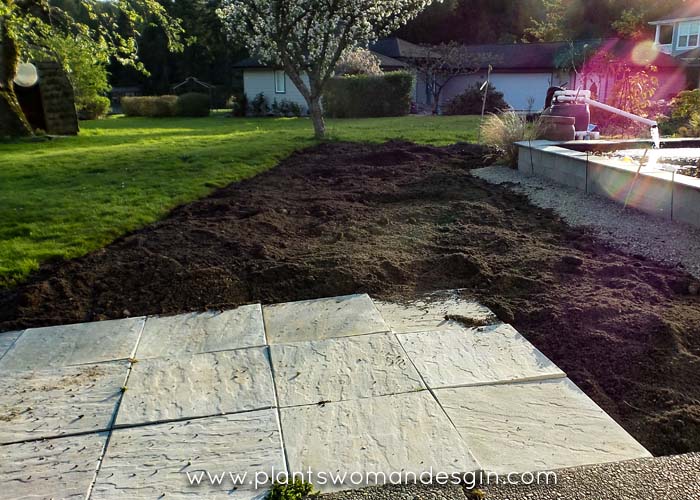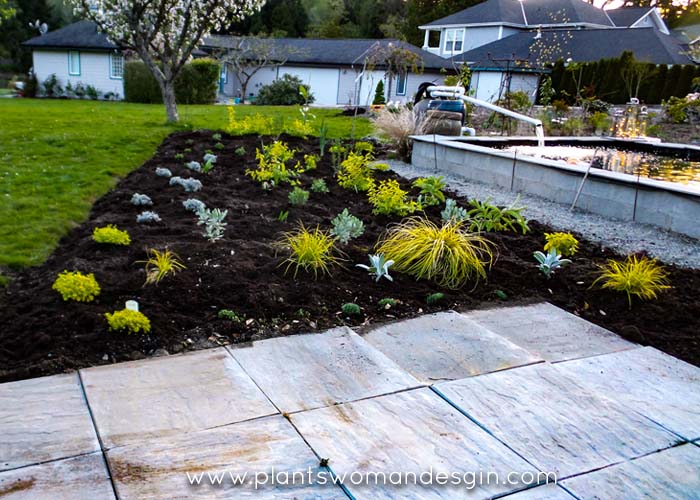Many of my clients have heard me say, “I don’t put it in your garden unless I’ve grown it myself.’ I am always experimenting and trying out new plants. After one Northwest Flower and Garden
But, because of my field testing, my garden can look a little haphazard. Sometimes I will put a plant in two different areas to test drainage, hardiness, or sun/shade. Or plant three or more of the same species of plant in various colors together. Experimentation is exciting when plants that are not hardy survive, unexpected color combinations present themselves, and learning that not giving a plant everything it wants keeps it under control. Dead plants will always be a design flaw. Invasive plants are also a design flaw.

Pictured above is a newly created bed in my garden. As I contemplate the design for this bed, I’m taking a walk in my client’s shoes. The result is a design that would satisfy many of my customers. Striving for a minimal color pallet in leaf color, bloom and texture it looks and will look amazing. All the foliage in the bed is bright green and blue-gray. The flowers will be either white or lavender and blue. I dropped in three contrast plants to make the bed continue to pop in the late summer. A gray leafed Lobelia tupa with a brick red flower, and colocasia sangria, a gray leafed elephant ear with a red stem, and a low groundcover geranium ‘Hocus Pocus’ with a dark red leaf and blue flower.

Here’s how I planned this bed along with 5 useful tips for designing your garden bed.
1. Choose for height. There are higher plants in the center with graduating heights toward the edges. The far end of the bed has a taller section with an evergreen
2. Choose evergreen, deciduous, and perennial plants. I want to be sure that the bed looks good year-round. This bed is right in front of the window that looks towards the koi pond. So I made sure to strike a balance between all the elements so there are no big blank spots that would show up in the winter or summer because of dormancy.
3. Choosing color and texture. I pay close attention to the play of texture and color in leaves. The balance of texture between the Carex ‘Evergold’ and Stachys Bella Grigio’s blooms is just as exciting as the contrast in leaf color. The spikes of Agapanthus ‘Blue Leap’ between Lavender ‘Richard Gray’ and Spirea ‘White Gold’ are also an exciting combination.
4. Bloom time. Surprising enough, the last thing that gets consideration from me is the flowers. Because there are so many great plants to choose from, it is easy to get the flower color right. Early blooms from the geranium and the campanula ‘Dickensens Gold’ will be the first to show here. The Agapanthus, Lavender, and Centaurea
5. Site considerations (AKA where is the sun). Usually, this is pretty easy to define. Sometimes you can add something that likes shelter behind something more prominent. The Lobelia
Variations in the number of plants are flexible and entirely up to the designer. Repetition of plants creates rhythm and looks natural because, in nature, plants do seed around and create groups.
Plant List for Hot and Bright!
Lobelia Tupa, Caryopteris ‘Dark Knight’, Agapanthus ‘Blue Leap’, Spirea ‘White Gold’, Geranium ‘Hocus Pocus’, Campanula ‘Dickenson Gold’, Carex ‘Evergold’, Colcasia ‘Sangria’, Lavender Richard Gray, Centaurea simplicicaulis, Salvia elegans ‘Gold’, Pervoskia atripicifolia, Stachys ‘Bella Grigio’, Saxifraga crustata, Salvia nemerosa ‘Blue Marvel’, Panicum ‘Ruby Ribbions’.


